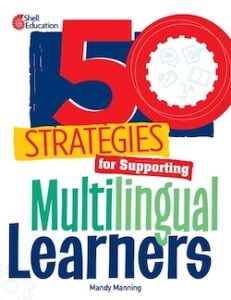50 Strategies for Supporting Multilingual Learners
By Mandy Manning
(Shell Educational Publishing, 2024 – Learn more)
Reviewed by Jeanette Pine
 Mandy Manning’s book is organized into two parts, Introduction and Strategies. At the end of the slim, 96-page book, Manning includes a one-page list of basic references that span from the 1980s through 2024.
Mandy Manning’s book is organized into two parts, Introduction and Strategies. At the end of the slim, 96-page book, Manning includes a one-page list of basic references that span from the 1980s through 2024.
She is careful to use the preferred “asset-based terminology” regarding students acquiring English: “English learners’ is now preferred to ‘English-language learners’ when referring to students in programs where they learn the English language.”
The entry also allows for the use of “multilingual learners” on second reference, as well as “emergent bilingual learners,” “English-language learners,” and “bilingual learners’’ when used by sources in quotes. (Source – The Debate Over English Learner Terminology, Explained by Ileana Najarro)
The privilege and power of teaching
 In Manning’s welcome page, she shares her teaching philosophy and the ways in which teachers impact not just the students in their classroom but generations of people:
In Manning’s welcome page, she shares her teaching philosophy and the ways in which teachers impact not just the students in their classroom but generations of people:
“Being a teacher is a tremendous gift exchange. Not the exchange of physical things, but of what really matters in our lives – human connection and the gifts we receive when we share our cultures, our experiences, and our talents with one another to make our classroom communities places in which every student feels valued, welcome and able to learn” (5).
Manning, the 2018 National Teacher of the Year, views teaching as a “privilege,” an “honor,” and “a gift” with the possibility of deep, soulful connections beyond the classroom. The book’s strategies are informed by these principles, especially in the “More for You” and “Keep in Mind” sections included with each strategy lesson.
Language acquisition basics
The Introduction serves as a basic primer regarding language acquisition. Because this information is most likely taught in every multilingual education graduate class, there’s nothing new for those whose primary role is teaching multilingual students.
However, for teachers who are new to the world of language diversity, this section is extremely helpful and would be a great anchor/resource for professional development for general education teachers and staff. The suggestions in the subheading “How to Use This Book” will guide teachers’ decision making for classroom libraries, as well as ideas to create nurturing class cultures, building classroom communities and the importance of and ways to develop basic interpersonal skills.
One important recommendation that would serve every staff member who interacts with multilingual learners is to understand students’ backgrounds and dietary restrictions. In addition, these staff members need to be made aware of any trauma students may have suffered while not requiring that students “relive those traumas” (13). All school staff should be aware that “using a condescending tone or increasing your volume” (12) is not a helpful strategy. Sometimes these ideas need explicit expression, regardless of how obvious they may seem.
Learning task strategies
A table of contents for strategies is on page 14. Strategy pages, typically 1 to 2 pages long, are clear, concise, and easy to navigate. Strategies are organized to highlight specific learning tasks: Creating a Supportive Learning Environment, General Language Support Strategies, Strategies for Listening and Speaking, Strategies for Reading, Strategies for Writing, Visual Literacy Strategies and Supportive Assessment. The arrangement of these ideas is perfect, and the strategies follow a predictable, highly implementable format.
Manning breaks down each strategy into three groups: PK-1, grades 2-5 and grades 6-12. Manning includes a “Make it Real” block of suggestions; a “More for You” paragraph that provides context; logistical suggestions, and how the ideas support the research. She also includes a “Keep in Mind” block that informs the “why.”
For example, Manning reminds teachers that “multilingual learners have a heavier cognitive processing load than their English-speaking peers. Often students must translate what they are hearing or reading into their first language, and then translate again from the first language into English to write or speak” (23).
Manning reminds teachers that “multilingual learners who attended school in other countries may not understand U.S. classroom expectations” (34). She notes that “it is better to model than to correct. Instead of telling a student they phrased something incorrectly, repeat what they said using the correct phrasing. Do this as often as necessary” (95).
These, and many other reminders to teachers and staff, are critical because they help forge the bonds of empathy that are key to multilingual students’ overall success, not only with academics and language acquisition but also for social-emotional support.
The references section contains the research and researchers one would expect in an introductory text, including the WIDA English Language Development Standards Framework 2020, TESOL Journal articles, the 2008 work of Jim Cummins, “BICS and CALP: Empirical and Theoretical Status of the Distinction,” and the OG of multilingual learning, Stephen Krashen, and his 1981 opus, “Second Language Acquisition and Second Language Learning,” a work which continues to inform much of what we do in the classroom to support multilingual learners.
A school-wide resource
This book is not only an ideal general education classroom resource, it should be read by every person who serves multilingual students, including administrators, support staff, bus drivers, lunch aides, nurses, and custodians.
Read Mandy Manning’s MiddleWeb article:
“Supporting MLs: It’s Not Just One More Thing”.
Jeanette Pine has been teaching reading and writing to elementary and middle school students for over 20 years and earned her MA in Bilingual/ESL Education from Seton Hall University. She is a member of The Early Learning Networked Improvement Community of New Jersey (ELNIC) and is engaged in collective problem solving disciplined by applying improvement science methods that lead to scalable, sustainable and lasting improvement. She believes the benefits of literacy go far beyond academic achievement and literacy learning is a fundamental civil right.


